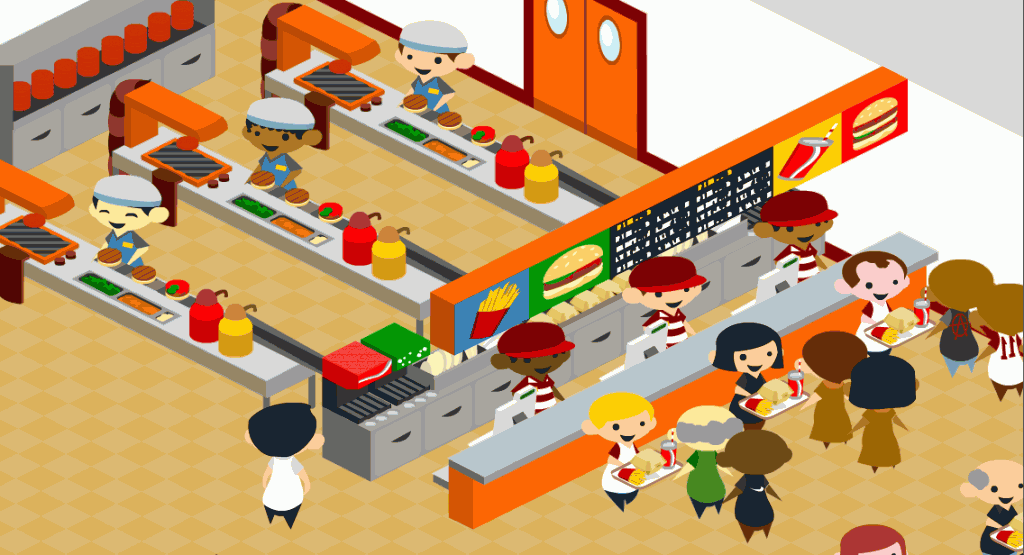This dispatch appeared in S02 Episode 3, along with The Any% History of Nintendo in China by Krish Raghav.
Krish: The first online phenomenon I ever obsessed over was a series of animated shorts called Xiao Xiao, each episode of which featured gorgeously choreographed stick-figure fights.

This was the mid-2000s, and every Xiao Xiao drop, provenance unknown, came with immense anticipation. It was the kind of mysterious oddity the web seemed built for, a proto-meme distributed like xeroxed zines via downloadable Adobe Flash files. I didn’t know it then, but Xiao Xiao was a breakthrough hit of China’s so-called “Flasher Generation,” a rag-tag assemblage of young designers, illustrators and animators in the early 2000s who were using the then-new Flash platform to create games and craft weird experiments.
It’s hard to overstate how magical this aspect of the early web was. It enabled people like me, a 10-year old on screeching dial-up connections in India, to follow a Beijing-based animator’s work through email-chain forwards and dodgy links.
Flash and browser games are often seen as marginal to videogame histories, but the Flashers in China created shared memories for an entire generation. The experimental playground they pioneered was a gateway into gaming for thousands of designers, coders and illustrators.
Their wild creativity (and rapacious piracy) was also a glimmer of what an open Chinese web might have looked like.
In this episode, Zoe unpacks the legacy of Flash games in China, and speaks to the historians and vloggers preserving them—as heritage, as memory, and as signposts to a different kind of internet. To paraphrase the writer David Stubbs, maybe the games of the past carry not just a glow of nostalgia, but “possible dormant futures that have merely been deferred.”

Zoe: Web games are Chinese millennials’ shared memories. In elementary school in the early 2000s, our weekly “computer class” was the highlight—all kids wore their shoe covers to attend it. Before my family bought our first home PC in 2005, this 45-minute class was my sole access to computers and the internet. Clearly, in this scenario, I had to get as much as possible out of this rare encounter with the web. Enter browser games. The secret sauce that amped up my weekly 45-minute dose of happiness.
Before the rise of the mobile game, browser and PC games were everything. With our generation’s then-limited access to electronic devices, we were either on QZone (QQ空间) planting and stealing vegetables, or mining gold through a browser window.
Krish: Many of these browser games were built on Adobe’s Flash, a programming language and platform that, from 2000 onwards, created this explosion of DIY developers and small studios globally. The influence of Flash on modern games history is inescapable. Entire genres—endless runners, escape rooms—were popularized by Flash developers, and its designer-centric user interface meant animators, illustrators and writers, not just coders, could now self-publish games easily and go viral overnight.


Zoe: Back then, teachers and chicken parents were the only obstacles that stopped kids from playing video games.
Few even understood the medium, and these browser games spread quietly without any government scrutiny or moral panics (I should feel grateful for being raised in the 2000s). They didn’t need any “gamer” skill sets. The satisfaction of leveling up, the smooth animations, and the sound effect combination were appealing to every 10-year-old. It felt like watching an animation, but I could also interact with it. Isn't that what all video games are?
Krish: ...no.
Yan: Noooooo.
Zoe: Okay fine, but what I meant was that the learning curves for these web games were quite gentle. In some makeover games, players just have to click on virtual clothes, makeup, and accessories on the screen to put them on a cartoon character. That’s it. The hardware requirements were also not high. You didn’t need fancy high-performance video cards or high-core-count central processing units. In the era of slow ADSL connections, the games were able to load successfully (most of the time).

Zoe: Let’s talk about “Chinese-localized” Flash games first, the “汉化”的Flash游戏. Very much the 字幕组 or subtitle groups of games culture, these were fast, loose, and wild in their diversity. Really representative of their time.
I reached out to GM, a Bilibili vlogger and archivist of flash games in China to help explore the topic. His channel introduces both popular and rare games from the era, and interviews the original creators.
During our chat, we agreed on what a more proper title for him might be: a web game historian.
GM: Hi.
Zoe: So Flash became the main language for creating browser games in China beginning in the late 90s, and the first generation of Flash game designers called themselves “Flashers” (闪客). In 1999, 1st gen Flasher Gao Dayong (边城浪子) created “Flash Empire” (闪客帝国), China’s first Flash games platform. It hosted many of the OG Chinese browser games including Crazy Flasher (闪客快打) and the aforementioned Xiao Xiao series (小小作品). Flash’s ease of use made it quickly popular among Chinese netizens. It wasn’t just games—this famous animated music video for Cui Jian’s “Rock ‘n’ Roll on the New Long March” (新长征路上的摇滚) was created in this era by Flasher Lao Jiang (老蒋). After it appeared on Flash Empire in 2000, Cui Jian himself approached Jiang and asked him to help produce some live visuals for his shows.
GM: People found these things magical because it was unimaginable at that time: images moving, sounds playing on your browser. Now the whole world is filled with GIFs and streaming video, but back then such things were not popular, and videos were not common. Hence Flash found its first opportunity to thrive.
Zoe: By the time I was tip-toeing into computer labs in the early 2000s, the most popular browser game pages were on 4399.com and 7k7k.com. 4399.com was established by Li Xingping (李兴平), who also founded the online listings portal hao123.com. Like hao123, 4399’s goal was to be a “hub” for anything you might need. Behold this magnificent piece of 2000s Chinese web design:

Gold Miner (黄金矿工) was widely acknowledged as the top flash game of this time. Gold Miner’s rules were quite simple: get the gold, avoid the rest. In the game, an old man (netizens nowadays call him “old Lionel Messi”) stands at the top of the screen, fishing for gold embedded in the ground below him. At the start, his grappling hook oscillates back and forth in an arc until the player pushes a button, which sends the hook shooting downward in a straight line to grab whatever is in its path. The goal of the game is to collect as much gold as possible before time runs out while avoiding undesirable items like rocks and underground critters.

The game was made by developer Dan Glover in 2003, but its spread through the Chinese web was marked by cracked versions and copycat hackjobs. Most websites just pirated the game in its entirety from its original version on the Game Rival site without the creator’s authorization, and all attempts at encryption and copy-protection failed. GM reached out to Dan Glover in 2020, and Dan didn't even know his game was wildly popular in China until...2021.
GM: None of the Flash game designers I interviewed for my own vlog channel were aware of the fact that their games became viral in China. There is no exception. None of them.

Zoe: Gold Miner’s experience was the norm. Most web games on 4399 and 7k7k were pirated. Regardless of my sympathies as an avid childhood fan, I have to say browser game sites are a bunch of shameless copyright thieves. According to multiple Zhihu and Douban users, more than 98% of web games on 4399.com are reproduced without the original game creators’ authorization.
Even Chinese independent game developers usually couldn’t prove that they owned their own game’s copyright and typically resorted to creating a special version for 4399 to replace pirated versions on the site. Meanwhile, foreign developers didn’t even know their games had been pirated. In a nutshell, 4399 blatantly robbed these games from their creators.

GM: These platforms infringed game copyright for sure, and often even their stolen versions were stolen from foreign pirate groups and crackers.
In sharp contrast, and the dominant global source of Flash-era creativity, was Newgrounds, a kind of Steam for Flash games. The site was like a community/BBS where everyone could share their own designs and exchange ideas. Newgrounds accepted all types of Flash designs with no discrimination against designers’ skill levels or techniques. So games like Dad n’ME (狂扁小朋友) could get discovered and spread globally. In my opinion, Newgrounds was why Flash games flourished and developed so fast.

Zoe: In a way, 4399 and its peers in China were just vultures scavenging the left-overs from the master predators.
GM: It’s hard to tell whether these pages at least did some good to promote Flash games, since without these websites, some games might never have been known and played by so many people.
Zoe: I consider the golden age of Flash games as the Warring States period of internet history. During the Warring States period philosophies and schools flourished in an era fraught with chaos and bloody battles. Chaotic, but it was also known as the Golden Age of Chinese philosophy since thoughts and ideas were developed and discussed freely.
Krish: It’s fascinating that a similar flourishing (of both avant-garde experiments and softcore sleaze) was happening in China in another medium at the same time: comics. The indie underground comics anthology SC (Special Comix, 特别漫画) was, like Flash, an equalizer of sorts—curating but not gatekeeping the work of many young Chinese comic artists. The contents page of any SC compilation reads today like a dream team of some of the biggest names in the field, and I wonder if Flash was similarly a riotous proving ground for China’s future coders and designers.
Simon: I missed out on this era in China, yet the scene of a few stolen minutes in the computer lab playing Flash games does really bring me back to middle school. Maybe part of the reason we feel so much nostalgia for this era of gaming and computer games is because there was a more clearly defined divide between online/offline.
Tianyu: I was born too late to witness the early days of indie games developers, but in the early 2010s a lot of the young programmers I knew of had started their career writing ActionScript 3. For me, I grew up with Seer (赛尔号) and Mole’s World (摩尔庄园), both online adventure games (for kids) designed by the Shanghai-based studio TaoMee. Happy Farm (开心农场) and its clones were also very popular once, during the heydays of SNS platforms Renren, Qzone, and Kaixin (better known as 偷菜, the game allows you to grow and steal crops from neighbors). As web payment remained inconvenient, I had to go to convenience stores for top-up cards (Tencent’s QQ卡 and TaoMee’s 米米卡). It was much more difficult for independent developers to monetize.
Even: This is an open question, but I wonder how Flash games interacted with/fed into the small gaming companies that started building “social games” in this period. There were a lot of acquisitions as well as outright theft BY foreign companies of Chinese-designed games (Happy Farm to Farmville being the most well-known example), driven by this fascination with monetization that Tianyu mentions.

GM: Flash, and Flash games, made the social game scene possible. It was a symbiotic relationship—the entire Facebook games genre that emerged around 2009 with companies like Zynga would not have existed without the “non-profit” Flash scene that came before.
Aaron: I really think the Chinese game world’s origins in flash and other casual forms of the medium led to Chinese mobile game companies becoming the international juggernauts they are today. While major talent in other countries was consumed by console wars and next-gen specs, Chinese game-makers had little problem moving from flash and browser games into mobile games that anyone with a phone could pick up and play, no matter where they were in the world. Much like what happened with broader internet culture, it’s ironic that games often made with zero expectation of profit helped establish one of the most aggressively monetized and lucrative types of games.
GM: Definitely. A big part of this energy came from the fact that most designers got into Flash purely out of interest and passion. No one thought that they could make money from it. Although the commercialization of Flash animation was relatively early, around the beginning of 2000, Flash games did not generate any profits for anyone until 2007 or 2008, when sophisticated advertising code could be embedded into games, or web ads in general began to take off.

Before the social games era, there was no money to make. It just attracted this wide group of people with diverse interests to join the community and make games. It was pure enjoyment, a “抱着玩的心态.”
Zoe: I believe this is the grassroots and proletarian nature of Flash games.
GM: China’s Flash community was also fairly isolated. Apart from the rampant piracy, there was no substantial exchange between China and other Flash scenes except for Xiao Xiao.
Xiao Xiao is probably the only Chinese-made Flash creation that spread beyond the country. First of all, with no doubt, the quality and the creativity are phenomenal. In addition, the stick figure aesthetic traveled easily, and capitalized on the global popularity of kungfu films and franchises like The Matrix.
Krish: It’s tragic that Xiao Xiao was just an anomaly—the sole breakthrough hit of the scene. It’s important to clarify here that it was the community that made Flash what it was. Part of the tragedy of Flash is that it belonged to a company (Adobe) that didn’t know what to do with it, and consistently failed to make it more robust and open.
Zoe: Yes, Flash faded from relevance by the late-2000s, and was retired completely in 2020. Security concerns and irrelevance meant Flash was no longer bundled with Windows or modern browsers, making many of these older games unplayable. Fortunately, Flash game archival projects like BlueMaxima (and GM’s own work) have saved many classics, and underscored the importance of Flash-based web games and animations to contemporary web culture at large.
GM: After Flash’s gradual exit from history, the major coding language to create web games was HTML 5. However, the popularity of HTML 5 is nowhere close to Flash’s. The key reason being H5 is not as easy to learn, and so the golden age of Flash games just can’t be recreated anymore. Despite Adobe’s missteps, Flash opened the gate to everyone who wanted to try creating animations or video games as long as you had the heart to learn. The software was available to download (or pirate). The creation process was simple and straightforward—frame by frame by frame. And that was it.

Zoe: There was an “irreducible individuality” to the Flash scene that seems lost in today’s web. It was vibrant, bringing to life so many fun animations and games. In my opinion, it was the most creatively liberating web technology of the 90s and 2000s—both a generational marker and the inspiration for those who would later shape Chinese animation. It was more than just a mere web technology. It created habits of mind, ways of knowing. It introduced a whole universe of new aesthetics.
I miss the Flash era. It was a time when “censorship” wasn’t the primary frame around which creativity on the Chinese web was measured. When talent, ideas and creativity could flourish just because people came together for fun. And to mine more gold than anyone else.
Zoe is a Dongbei migrant worker based near Chaoyang.
Krish is a comic book artist in Beijing who once made Flash games that no one will ever play.
Slowork is a Beijing observer and an oddity illustrator.
GM is on Bilibili.
Tianyu Fang is a writer in California. He dreams of moving to a farm, where he will be growing real crops—and stealing his neighbors’.
Yan Cong was born in Xicheng, grew up in Haidian, and is now based in Amsterdam, via New York and Chaoyang. She’s currently obsessed with the game Unpacking, which you cannot play on flash, but can play on Nintendo (Switch... and Steam).
Even is an ag analyst who has been known to play farming games out of nostalgia for an agrarian way of life.
Henry Zhang is a writer who lives in New Haven and dreams of Chaoyang.
Simon Frank lives in Chaoyang and has roots in New Haven.
Aaron Fox-Lerner is a New York-based writer. Somehow he had no idea the stick figure animations named “Xiao Xiao” he watched as a middle schooler were from China.
